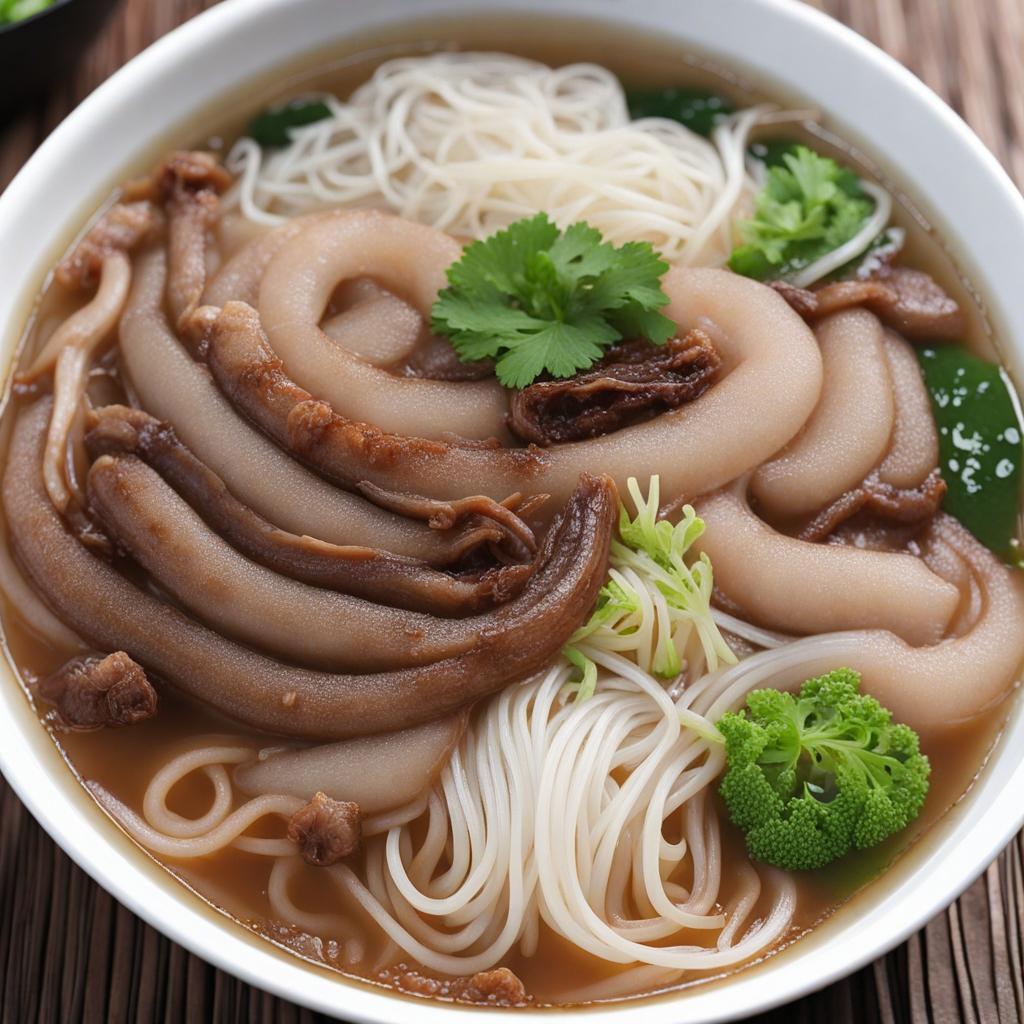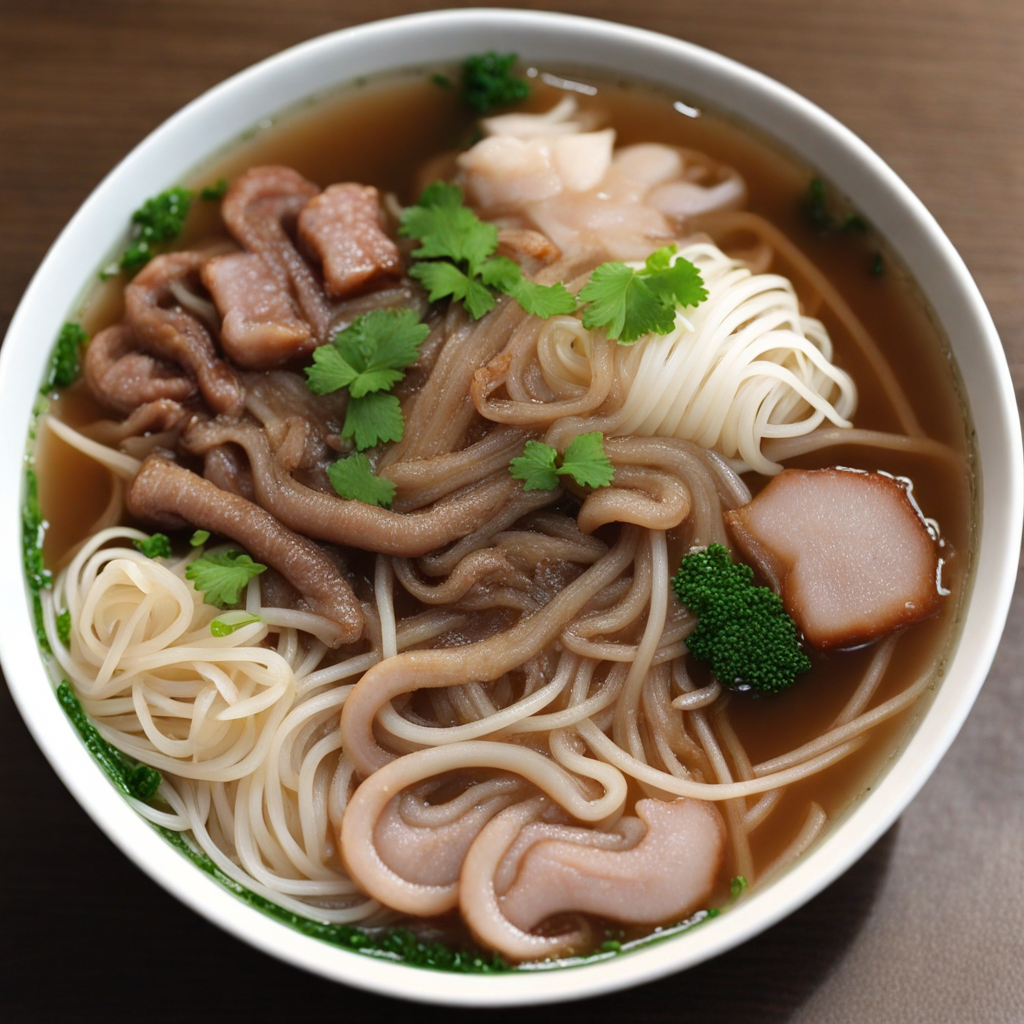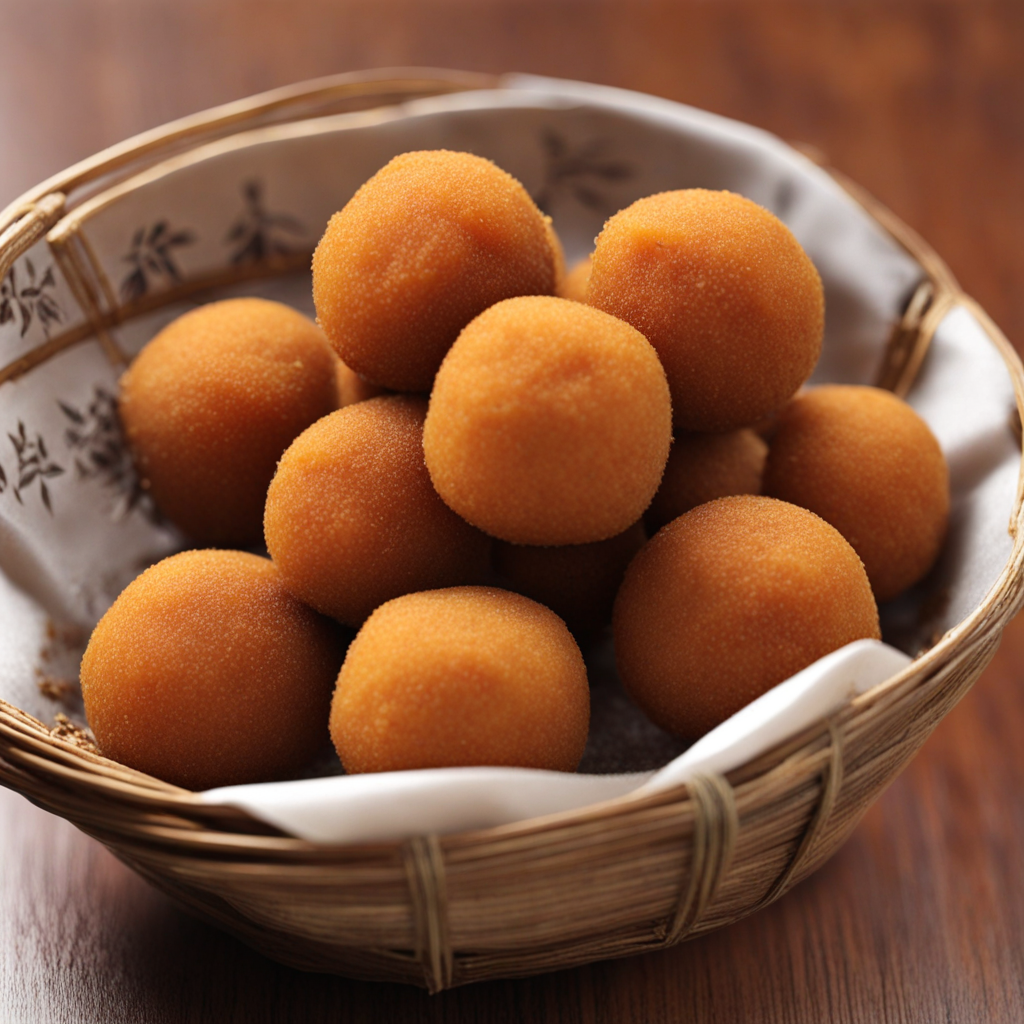Intestine Vermicelli
Intestine Vermicelli, known locally as "Chao Guo" or "Intestine Mee Sua," is a hearty and flavorful dish that showcases the unique culinary traditions of Taiwan. At its core, this dish features delicate vermicelli noodles that are cooked until tender and then generously topped with stir-fried pork intestines. The intestines are typically marinated and seasoned with a mix of aromatic spices, giving them a rich and savory flavor that contrasts beautifully with the lightness of the noodles. The dish is often served in a warm, savory broth that adds depth and enhances the overall taste experience. To elevate the dish further, Intestine Vermicelli is commonly garnished with fresh herbs, such as cilantro and green onions, along with a sprinkle of fried shallots for an extra crunch. Some variations may include a splash of soy sauce or chili oil, allowing the diner to customize the level of heat and richness according to their preference. The broth, infused with the essence of the pork and spices, is not only comforting but also invigorating, making it a popular choice among locals and visitors alike. What sets Intestine Vermicelli apart is its combination of textures and flavors. The chewiness of the vermicelli, the tender yet slightly crispy intestines, and the aromatic broth come together to create a dish that is both satisfying and memorable. As you savor each bite, you'll find the complex layers of taste that characterize Taiwanese cuisine, making it a must-try for adventurous eaters looking to explore new culinary horizons.
How It Became This Dish
The History and Cultural Significance of 大腸麵線 (Dàcháng Miànxiàn) Origins and Early History 大腸麵線, pronounced as Dàcháng Miànxiàn, is a beloved Taiwanese dish that has its roots deeply embedded in the island's complex history and cultural tapestry. The term "大腸" translates to "large intestine," while "麵線" means "thin noodles." The dish essentially consists of thin wheat noodles served in a rich and savory broth, often accompanied by pork intestines, and garnished with scallions, cilantro, and sometimes a sprinkle of white pepper. The origins of Dàcháng Miànxiàn can be traced back to the Fujian province of China, particularly to the Hokkien culture. During the 17th century, when the Chinese first began migrating to Taiwan, they brought with them their culinary traditions. The use of intestines in cooking was a common practice in various Chinese cuisines, particularly in Hokkien and Cantonese cultures, where every part of the animal was utilized to minimize waste. This frugality laid the groundwork for the creation of Dàcháng Miànxiàn in Taiwan. Cultural Significance Dàcháng Miànxiàn is not merely a dish; it is a cultural emblem of Taiwan's rich culinary identity. It reflects the influence of Hokkien culture and symbolizes the integration of various traditions brought by immigrants. The dish has become particularly popular in night markets, where it is often served as a comfort food, attracting both locals and visitors. In Taiwanese society, food plays a critical role in social gatherings, festivals, and family traditions. Dàcháng Miànxiàn is often enjoyed during celebrations, such as birthdays or the Lunar New Year, emphasizing its significance beyond just sustenance. It embodies a sense of nostalgia and connection to one's roots, serving as a reminder of the island's diverse heritage. Development Over Time The evolution of Dàcháng Miànxiàn reflects the broader changes in Taiwanese society. In the early years after its introduction, the dish was primarily enjoyed by working-class families, as it was a hearty meal that was both affordable and filling. Street vendors began to sell the dish in bustling markets, making it accessible to a wider audience. As Taiwan underwent rapid urbanization and industrialization in the latter half of the 20th century, street food culture flourished, and Dàcháng Miànxiàn became a staple. In the 1980s and 1990s, as Taiwan’s economy began to thrive, so did its culinary landscape. The Taiwanese people developed a growing appreciation for traditional foods, and Dàcháng Miànxiàn enjoyed a resurgence in popularity. Restaurants specializing in this dish began to emerge, each putting their unique twist on the classic recipe. Variations began to appear, incorporating different types of broth or toppings, such as quail eggs, fried shallots, and even spicy elements that catered to modern tastes. Modern Adaptations In recent years, the globalization of food culture has brought Dàcháng Miànxiàn to the international stage. Taiwanese cuisine has gained recognition worldwide, leading to the establishment of Taiwanese restaurants in major cities across the globe. Chefs and owners often highlight Dàcháng Miànxiàn as a must-try dish, presenting it with an emphasis on authenticity while also experimenting with fusion elements. For instance, some contemporary interpretations have introduced vegan versions that replace the pork intestines with plant-based substitutes, catering to the growing demand for vegetarian and vegan options. Others have reimagined the dish by introducing international flavors, showcasing the adaptability and resilience of Taiwanese cuisine in an increasingly interconnected world. Nutritional Aspects and Cooking Techniques The preparation of Dàcháng Miànxiàn is a time-honored process that showcases the culinary skills of its makers. The broth is typically made by simmering pork bones, often infused with ginger, garlic, and soy sauce, creating a robust flavor profile. The intestines, which are the star of the dish, are cleaned meticulously and often cooked separately to ensure that they are tender and flavorful. Cooking Dàcháng Miànxiàn is both an art and a science. The thin noodles are blanched before being combined with the broth, allowing them to absorb the rich flavors. The dish is then garnished with fresh herbs and spices, creating a colorful and aromatic presentation. The balance of flavors—salty, savory, and slightly sweet—makes Dàcháng Miànxiàn a comforting meal that resonates with many. Conclusion In conclusion, 大腸麵線 (Dàcháng Miànxiàn) is more than just a bowl of noodles; it is a reflection of Taiwan's historical journey, cultural diversity, and culinary evolution. From its humble beginnings in Fujian to its current status as a beloved Taiwanese comfort food, Dàcháng Miànxiàn encapsulates the essence of Taiwanese identity. As the dish continues to adapt and thrive in a globalized world, it remains a vital link to the past and a cherished part of Taiwan's culinary future. Whether enjoyed at a bustling night market or a cozy family gathering, Dàcháng Miànxiàn serves as a delicious reminder of the island's rich heritage and the stories that food can tell.
You may like
Discover local flavors from Taiwan







